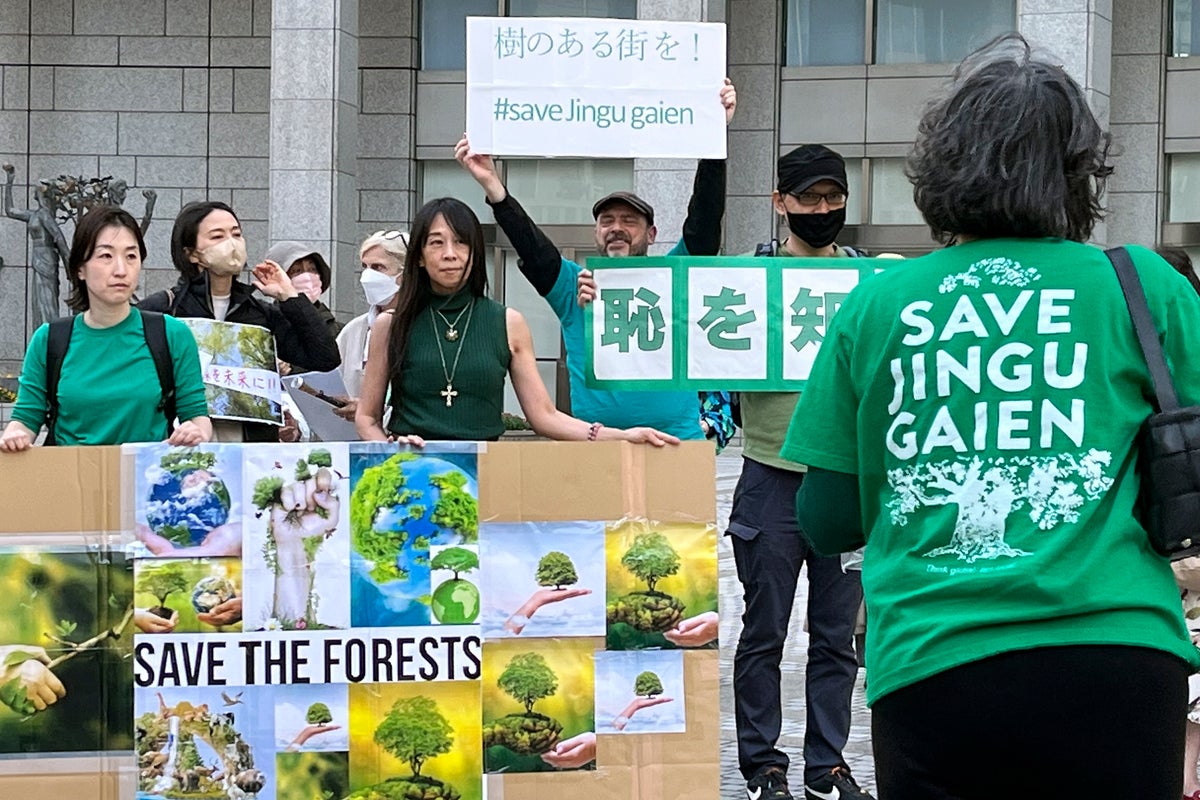
The Jingu Gaien area in central Tokyo is a cultural and historic treasure, a mostly green space set aside almost 100 years ago with private donations to honor Japan's famous Meiji Emperor.
With the tacit support of Tokyo Governor Yuriko Koike, a real estate company is planning to redevelop the green enclave with a pair of highrise towers — about 190 meters (620 feet) each — and a smaller 80-meter (260-foot) companion.
Plans also call for razing a famous baseball stadium where Babe Ruth played — and demolishing an adjoining rugby venue — and rebuilding them on a reconfigured tract that provides more commercial space.
"This is like building skyscrapers in the middle of Central Park in New York,” Professor Mikiko Ishikawa told the Associated Press.
Ishikawa is an emeritus professor at the University of Tokyo who did her doctorate at Harvard University, where she studied landscape architecture and Central Park's history. She said Central Park was an inspiration for the Japanese — as were European designs — when Jingu Gaien was completed in 1926.
“Tokyo would lose its soul," said Ishikawa, who described the area as “the showroom of the Japanese nation” when it was opened.
“Jingu Gaien is a public place, and you should think of it as a commons," she said.
The controversial, billion-dollar project pits a diverse group of activists, preservations, and local residents against Koike, the metropolitan government, and real estate developer Mitsui Fudosan.
The project will take more than a decade to complete, but Koike has allowed some limited construction to begin despite questions about the environmental impact.
“The Jingu Gaien was paid for by private money, maybe the earliest example of crowdfunding," Ichikawa said
Opponents have filed suit seeking an injunction to stop the project, which would allow environmental issues to be addressed and explore if the area needs a radical makeover.
“For me and other people who live in the neighborhood, we never dreamed there would be anything like this happening,” said Tenco Tsunoi, a graphic designer who opposes the project.
“It was a complete shock,” added Tsunoi, who said the project was done “very quietly” by the city and the developer.
Activists have gathered almost 200,000 signatures on a petition to stop the project. And a newspaper poll conducted by Tokyo Shimbun last year showed 69.5% against the project.
Famous Japanese composer and musician Ryuichi Sakamoto, days before his death on March 28, sent an emotive letter to Koike to oppose the project as his last cause. About 6,000 gathered earlier this month near the National Stadium to remind Koike of his wishes.
Sachihiko Harashina, an engineer who specializes in environmental planning and is the president of Chiba University of Commerce, said Koike seemed to favor the developers.
“If the governor has a mind to hear the voice of the people, she should make more communication with the people," Harashina said in a email to AP.
Harashina is a leading international and national expert on Environmental Impact Assessment, or EIA. He termed as “very poor” the quality and thoroughness of the impact assessment on this project.
“I should say this is one of the poorest EIAs in Japan,” he said. He said the city’s own Environmental Assessment Committee has pointed out several flaws.
“One of the major problems in the process of the EIA for the Jingu Gaien redevelopment project is the lack of scientific analysis of the ecosystem of the park," Harashina said.
Harashina and others say that Koike could stop the project if she wished.
Koike addressed Jingu Gaien several months ago at news conference. A Japanese reporter, posing a question, told Koike that local statutes require her to "take measures in the event that business engages in fraudulent behavior.”
“There are people who have great interest in this matter — people who are opposed and people who are very active,” Koike replied. “There are people who voice such concerns but this issue is going through procedural steps — fraudulent or not.” She said the city council was “currently deliberating on this matter.”
The flashpoint has been trees, green space, and who controls a public area that has been encroached on over the years. Also at issue is the fate of more than 100 ginko trees that line an avenue in the area and provide a colorful cascade of falling leaves each autumn.
The developer says the trees on the avenue will be kept, but 18 others away from the main avenue will be felled. In addition, Ichikawa said the root system of the remaining ginko trees will be damaged — perhaps killed — when the new baseball stadium is built within about 8 meters (25 feet) of the tree line.
About 1,500 trees were cut down to build the National Stadium for the 2020 Tokyo Olympics.
The Olympics, caught up in a corruption and bribery scandal over the last several years, also helped the city pass legislation to remove height restrictions in the Jingu Gaien area. Activists believe planning for the project began a decade ago.
“Up until now, Tokyo has preserved a lot of these public spaces,” Ichikawa, the landscape architect said. “If this goes through, this will be the first one of these preserved places that will be completely destroyed. This will be like a tidal wave, or the domino effect. If this can go forward in Jingu Gaien, what’s next?”
___
Follow Japan-based AP Sports Writer Stephen Wade on Twitter at http://twitter.com/StephenWadeAP







